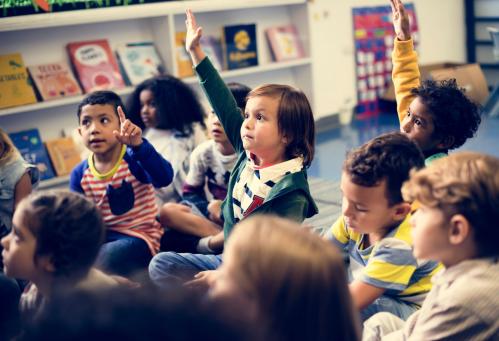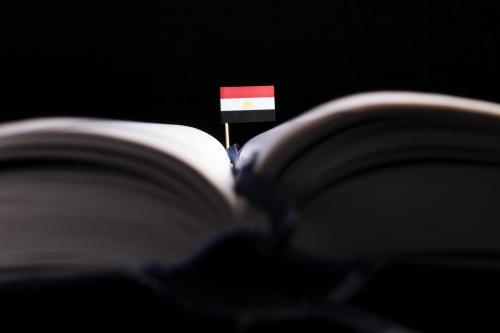Editor’s Note: In this blog series, Sarah Dryden-Peterson and Elizabeth Adelman explore the experiences of Syrian refugee children and their teachers, drawing on long-term observations and interviews in Lebanon in formal and non-formal schools that serve Syrian refugees.
The Irada Valley School sits deep within Lebanon’s fertile Bekaa Valley. Visit on a sunny day and the view from the rooftop is equal parts stunning and sobering: expansive blue skies, emerald green fields, majestic mountains, and hundreds of tattered, disintegrating tents. These temporary shelters are home to over a thousand Syrian refugee families, the majority of whom do not have access to public schools. Of the more than 360,000 refugee children (aged 5 to 17) living in Lebanon, 49 percent are out of school.
Irada, a pseudonym, is a welcome addition to this community. This non-formal school serves over 600 Syrian refugee students from kindergarten through third grade and focuses on preparing students to enter the formal public system. Everyone who inhabits the space of this makeshift school—teachers and students alike—has had their lives disrupted by conflict.
Take Hadia (also a pseudonym). Hadia had been teaching kindergarten in Syria for over 10 years before the war forced her family to flee to Lebanon. She arrived four years ago, seeking a safer, more stable environment for her three children, two of whom are deaf. Unlike most refugees, Hadia was fortunate to have Lebanese relatives who could offer a temporary home. However, what may have seemed like a benefit to many, felt like a burden to Hadia. “I just wanted to relieve my dependency on my husband’s aunt. I don’t want to be like, ‘feed me and give me water.’ If I didn’t work, produce, and provide a living for my children, I wouldn’t be comfortable.”
Desperate to help support her family, Hadia applied for a job with Irada. She arrived at the interview knowing nothing about the organization except that it was actively looking for Syrian teachers. Hadia began teaching kindergarten at the school, and she has now been with Irada for one-and-a-half years.
Shared refugee identities help teachers create healthy classroom environments
Most of Hadia’s students are well above kindergarten age, which is not uncommon in refugee situations. They missed out on education as conflict came to their home areas in Syria and then arrived in Lebanon to find few opportunities to enter school. Yet over the past 18 months, Hadia has seen her students move from “not knowing how to write or read” to performing at grade level. She is immensely proud of them.
Hadia brings to the classroom more than just her teaching skills. She also brings a shared identity and a similar set of experiences. She says:
“I show [my students] inside the class that I am laughing and teaching, but my condition is just like theirs. I don’t have a house, I don’t have a country to live in… but in order to return to our country and do something, or even to do something in the country we are in, and change our condition—maybe if we studied and worked, we might get a house and teach, or be a lawyer or a doctor, anything. Be productive. Life is when you learn something.”
The International Network for Education in Emergencies’ (INEE) Minimum Standards provide a consensus framework for education in crisis settings. These standards emphasize the need for teachers to create “a safe and inclusive learner-friendly environment,” which Hadia strives for, centering her teaching on empathy and care. The standards also emphasize “an appropriate context-specific curriculum that is comprehensible and culturally, linguistically, and socially relevant for the learners.” We have found in other research in Kenya and Uganda that refugee teachers—more so than national teachers—are often more able to adapt proscribed curricula in these ways and to infuse these goals into classroom discussions and conversations. Even in moments as seemingly innocuous as free time for drawing, Hadia often confronts politically charged issues:
“Two boys came to me, one had drawn the revolutionary flag and the other had drawn the regime flag, and they started arguing which flag is ours, this or that, expecting me to answer them. I asked both of them if they had a house and they both replied with a ‘no.’ So I said how about we find a land where we can build a house, and then we argue about the flag. They agreed and went back to their seats.”
Hadia drew on her own experiences and identities as a Syrian refugee in Lebanon to handle this potentially explosive situation with care. Yet while the tension had been resolved for the moment, Hadia knew that another such incident was just around the corner. She does not always feel well prepared to meet the needs that her refugee children have.
Teachers of refugees need additional training
Hadia is not alone. Aaron (a pseudonym), like Hadia, is a refugee from Syria teaching at Irada City School. His energy in the classroom is infectious: students buzz around his room and hop in place as they tackle the engaging tasks set before them. Aaron likes to incorporate competitions into his lessons, dividing students into teams, each trying to get through an activity first. Students are never offered a prize; the promise of their teacher’s praise is enough. During today’s competition, focused on identifying plural nouns, children work fervently, huddled over worksheets in deep secrecy, debating answers in strong and excited whispers, popping up to inject a question directly into Aaron’s ear. One girl, though, sits silently in the middle of the commotion, completely unengaged, watching with a blank, empty expression. Aaron leaves her on her own, as do the other students. Like most Syrian refugee children, she has serious challenges related to trauma. No one in the classroom knows how to help her.
Hadia describes how she used to spend time online at home every day researching activities for refugees, those who have suffered due to conflict, how to help them. Still, she does not feel prepared to meet her goal of helping her refugee students change their condition and build productive lives for themselves in exile or in an eventual return to Syria. Aaron reads what he can on topics such as cognitive behavioral therapy but he admits that when it comes to supporting troubled students, “I don’t know how to, honestly…. I know I don’t have any tools…. I hug them and I tell them that things are going to be okay. I lie… Sometimes I just feel helpless and that I cannot help them, honestly. So I just [try to] promote a very healthy classroom environment and that I can do.”
Hadia and Aaron do a remarkable job of creating healthy classroom environments. Yet they need additional training to meet the needs of their refugee students. Globally, this is the number one request we hear from teachers of refugees. They wish for more and better-targeted professional development to help them create conditions in their classrooms where all of their students can learn.
Elizabeth Adelman is a doctoral candidate at the Harvard Graduate School of Education, where her research focuses on the experiences of teachers of Syrian refugees.


Commentary
Inside Syrian Refugee Schools: Teachers struggle to create conditions for learning
February 10, 2016